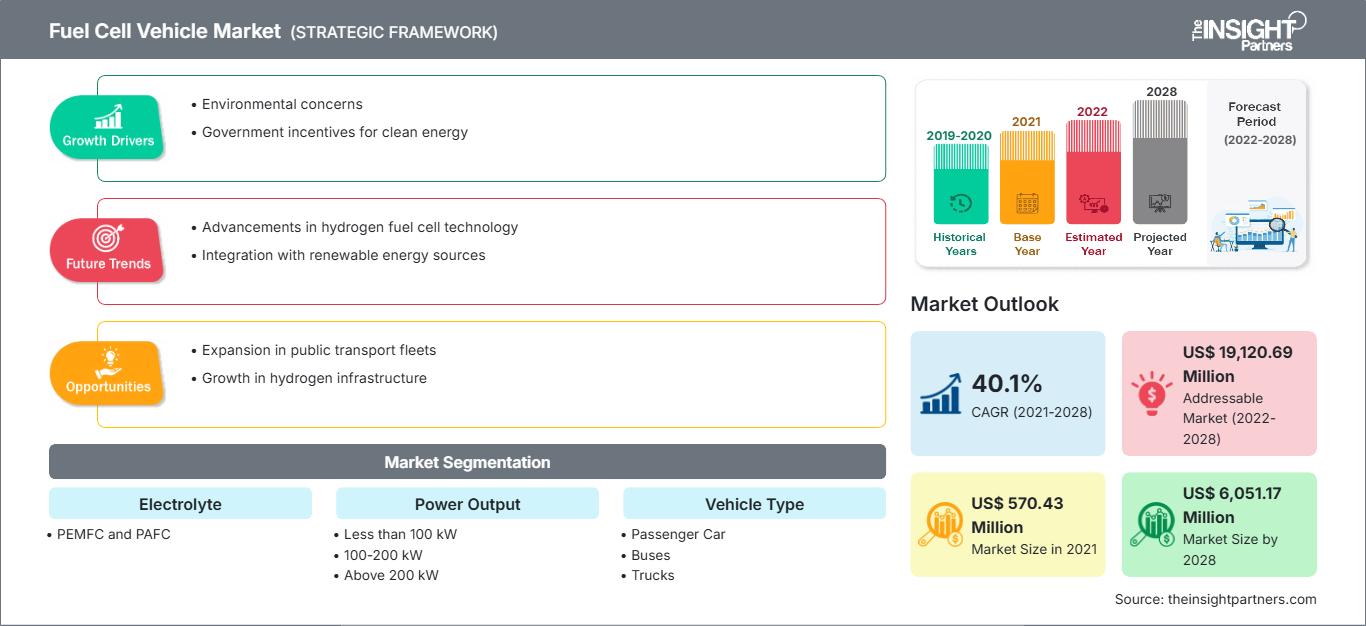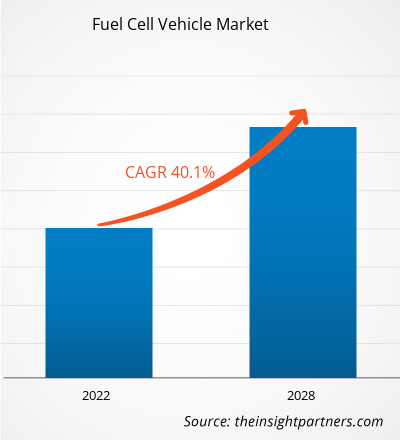[Forschungsbericht] Der Markt für Brennstoffzellenfahrzeuge soll von 570,43 Millionen US-Dollar im Jahr 2021 auf 6.051,17 Millionen US-Dollar im Jahr 2028 anwachsen; für den Zeitraum 2021–2028 wird eine durchschnittliche jährliche Wachstumsrate (CAGR) von 40,1 % erwartet.
Analystenperspektive:
In den letzten Jahren hat der Markt für Brennstoffzellenfahrzeuge als vielversprechende Alternative zu herkömmlichen benzinbetriebenen Fahrzeugen stark an Aufmerksamkeit und Dynamik gewonnen. Brennstoffzellenfahrzeuge (FCVs) werden von Wasserstoff-Brennstoffzellen angetrieben, die durch eine chemische Reaktion zwischen Wasserstoff und Sauerstoff Strom erzeugen, wobei als einzige Emission Wasserdampf entsteht. Einer der Hauptvorteile von FCVs ist ihre Umweltfreundlichkeit. Da sie nur Wasserdampf ausstoßen, tragen sie zur Reduzierung von Treibhausgasemissionen und Luftverschmutzung bei und tragen so den globalen Problemen des Klimawandels und der städtischen Umweltverschmutzung Rechnung. Diese Eigenschaft hat zu verstärkter staatlicher Unterstützung und Anreizen für die Einführung und Entwicklung der Brennstoffzellentechnologie geführt. Der Markt für Brennstoffzellenfahrzeuge verzeichnet ein stetiges Wachstum.
Automobilhersteller und Technologieunternehmen investieren massiv in Forschung und Entwicklung, um die Effizienz, Leistung und Erschwinglichkeit von Brennstoffzellenfahrzeugen zu verbessern. Dadurch hat sich die Reichweite von Brennstoffzellenfahrzeugen deutlich erhöht, was eine der anfänglichen Bedenken hinsichtlich der begrenzten Reichweite ausräumt. Obwohl der Markt für Brennstoffzellenfahrzeuge im Vergleich zu Fahrzeugen mit herkömmlichen Verbrennungsmotoren und Elektrofahrzeugen noch relativ klein ist, wird in den kommenden Jahren ein deutliches Wachstum erwartet. Die steigende Nachfrage nach nachhaltigen Transportlösungen sowie Fortschritte in der Brennstoffzellentechnologie und im Infrastrukturausbau dürften das Marktwachstum vorantreiben. Darüber hinaus fördern Partnerschaften und Kooperationen zwischen Automobilherstellern, Energieunternehmen und Regierungen das Wachstum des Marktes für Brennstoffzellenfahrzeuge. Diese Allianzen zielen darauf ab, die Einführung von Brennstoffzellenfahrzeugen zu beschleunigen und Forschung und Entwicklung zu fördern.
Marktübersicht:
Der Markt für Brennstoffzellenfahrzeuge konzentriert sich auf Fahrzeuge mit Brennstoffzellentechnologie, die Wasserstoff als Energiequelle zur Stromerzeugung nutzt. Der Markt verzeichnet aufgrund des zunehmenden Umweltbewusstseins und des Bedarfs an nachhaltigen Transportoptionen ein deutliches Wachstum. Staatliche Vorschriften und Anreize haben maßgeblich zur Verbreitung von Brennstoffzellenfahrzeugen beigetragen. Fortschritte in der Brennstoffzellentechnologie, die Zusammenarbeit zwischen Branchenakteuren sowie kontinuierliche Forschungs- und Entwicklungsanstrengungen haben das Marktwachstum weiter vorangetrieben. Herausforderungen wie hohe Kosten und eine eingeschränkte Infrastruktur bleiben bestehen, doch der Markt bietet erhebliches Wachstumspotenzial, da sich die Technologie weiterentwickelt und die Nachfrage nach saubereren Transportlösungen weiter steigt.
Passen Sie diesen Bericht Ihren Anforderungen an
Sie erhalten kostenlos Anpassungen an jedem Bericht, einschließlich Teilen dieses Berichts oder einer Analyse auf Länderebene, eines Excel-Datenpakets sowie tolle Angebote und Rabatte für Start-ups und Universitäten.
Markt für Brennstoffzellenfahrzeuge: Strategische Einblicke

- Holen Sie sich die wichtigsten Markttrends aus diesem Bericht.Dieses KOSTENLOSE Beispiel umfasst Datenanalysen, die von Markttrends bis hin zu Schätzungen und Prognosen reichen.
Markttreiber: Steigendes Umweltbewusstsein treibt Wachstum im Markt für Brennstoffzellenfahrzeuge an
Sie erhalten kostenlos Anpassungen an jedem Bericht, einschließlich Teilen dieses Berichts oder einer Analyse auf Länderebene, eines Excel-Datenpakets sowie tolle Angebote und Rabatte für Start-ups und Universitäten.
Markt für Brennstoffzellenfahrzeuge: Strategische Einblicke

- Holen Sie sich die wichtigsten Markttrends aus diesem Bericht.Dieses KOSTENLOSE Beispiel umfasst Datenanalysen, die von Markttrends bis hin zu Schätzungen und Prognosen reichen.
Das zunehmende Umweltbewusstsein hat sich als wichtiger Wachstumstreiber für Brennstoffzellenfahrzeuge herausgestellt. Da sich die Menschen der schädlichen Auswirkungen herkömmlicher benzinbetriebener Fahrzeuge auf die Umwelt immer mehr bewusst werden, steigt die Nachfrage nach saubereren und umweltfreundlicheren Transportalternativen. Dieses gestiegene Umweltbewusstsein hat ein günstiges Marktumfeld für Brennstoffzellenfahrzeuge geschaffen. Brennstoffzellenfahrzeuge nutzen Wasserstoff als Kraftstoffquelle, einen reichlich vorhandenen und sauberen Energieträger. Wenn Wasserstoff in einer Brennstoffzelle mit Sauerstoff gemischt wird, entsteht Strom, wobei Wasserdampf als einziges Nebenprodukt entsteht. Dieser emissionsfreie Betrieb ist ein Schlüsselfaktor, um umweltbewusste Verbraucher anzulocken. Das steigende Bewusstsein für Luftverschmutzung und Treibhausgasemissionen hat zu strengeren Umweltvorschriften durch Regierungen und Aufsichtsbehörden geführt. Viele Länder und Regionen haben sich ehrgeizige Ziele gesetzt, um die CO2-Emissionen zu reduzieren und nachhaltigen Verkehr zu fördern. Als Reaktion darauf konzentrieren sich Automobilhersteller zunehmend auf die Entwicklung von Brennstoffzellenfahrzeugen als Teil ihres Portfolios, um diese Vorschriften zu erfüllen und umweltbewusste Kunden anzusprechen.
Darüber hinaus haben die Fortschritte in der Brennstoffzellentechnologie zu deutlichen Verbesserungen der Leistung und Effizienz von Brennstoffzellenfahrzeugen geführt. Diese Fahrzeuge bieten nun größere Reichweiten und schnellere Betankungszeiten und sind daher alltagstauglicher. Die wachsende Infrastruktur für Wasserstofftankstellen unterstützt das Marktwachstum von Brennstoffzellenfahrzeugen ebenfalls, indem sie eine der größten Herausforderungen im Zusammenhang mit ihrer Einführung angeht. Darüber hinaus haben die zunehmenden Investitionen und Forschungsanstrengungen in die Brennstoffzellentechnologie von Automobilherstellern, Energieunternehmen und Regierungen die Entwicklung und Vermarktung von Brennstoffzellenfahrzeugen beschleunigt. Diese Investitionen haben nicht nur die technologischen Möglichkeiten von Brennstoffzellen verbessert, sondern auch zu niedrigeren Produktionskosten beigetragen und sie so wettbewerbsfähiger auf dem Markt gemacht.
Segmentanalyse:
Basierend auf dem Fahrzeugtyp ist der Markt für Brennstoffzellenfahrzeuge in Pkw, Busse, Lkw und leichte Nutzfahrzeuge unterteilt. Das Pkw-Segment hatte 2020 den größten Marktanteil und dürfte im Prognosezeitraum die höchste durchschnittliche jährliche Wachstumsrate (CAGR) verzeichnen. Aufgrund verschiedener Faktoren hat sich das Pkw-Segment zum größten Marktanteil für Brennstoffzellenfahrzeuge entwickelt. Der weltweit zunehmende Fokus auf die Reduzierung von CO2-Emissionen und den Übergang zu nachhaltigem Transport hat die Nachfrage nach Brennstoffzellenfahrzeugen erhöht. Automobilhersteller haben in die Entwicklung und Vermarktung von Brennstoffzellen-Pkw investiert und so deren Effizienz, Reichweite und Erschwinglichkeit verbessert.
Die Verfügbarkeit einer breiten Palette von Brennstoffzellen-Pkw-Modellen, Fortschritte bei der Wasserstoffinfrastruktur und die Vorteile der Brennstoffzellentechnologie wie große Reichweiten und kürzere Betankungszeiten haben zum Erfolg dieses Segments beigetragen. Insgesamt spiegelt das Pkw-Segment die zunehmende Akzeptanz und Realisierbarkeit der Brennstoffzellentechnologie in der Automobilindustrie wider.
Regionale Analyse:
Der Markt für Brennstoffzellenfahrzeuge im asiatisch-pazifischen Raum wurde 2021 auf 301,69 Millionen US-Dollar geschätzt und soll bis 2028 4.113,9 Millionen US-Dollar erreichen; im Prognosezeitraum wird ein CAGR-Wachstum von 45,2 % erwartet. Der asiatisch-pazifische Raum hat sich zur dominierenden Kraft auf dem Markt für Brennstoffzellenfahrzeuge entwickelt. Mit seiner enormen Bevölkerung, der schnellen Urbanisierung und den wachsenden Bedenken hinsichtlich Umweltverschmutzung und Klimawandel hat sich die Region aktiv für sauberere und nachhaltigere Transportalternativen eingesetzt. Einer der Hauptfaktoren für diese Dominanz der Region ist die starke staatliche Unterstützung und die Politik, die die Einführung von Brennstoffzellenfahrzeugen fördert. Länder wie Japan, Südkorea und China haben günstige Vorschriften, Steueranreize und Subventionen eingeführt, um die Nutzung von Brennstoffzellenfahrzeugen zu fördern. Diese Maßnahmen haben ein förderliches Umfeld für Hersteller, Investoren und Verbraucher geschaffen und das Marktwachstum gefördert. Insbesondere Japan ist Vorreiter bei der Entwicklung und Einführung von Brennstoffzellenfahrzeugen. Die japanische Regierung hat sich ehrgeizige Ziele für den Ausbau der Wasserstoffinfrastruktur gesetzt und strebt den Aufbau eines landesweiten Netzes von Wasserstofftankstellen an.
Darüber hinaus haben große japanische Automobilhersteller wie Toyota und Honda erheblich in die Forschung und Entwicklung von Brennstoffzellenfahrzeugen investiert, was zur Kommerzialisierung von Modellen wie dem Toyota Mirai und dem Honda Clarity geführt hat. Auch Südkorea hat auf dem Markt für Brennstoffzellenfahrzeuge bemerkenswerte Fortschritte gemacht. Die Regierung hat dem Ausbau der Wasserstoffinfrastruktur Priorität eingeräumt und die Einführung von Brennstoffzellenbussen und -nutzfahrzeugen aktiv unterstützt. Unternehmen wie Hyundai und Kia, beide in Südkorea ansässig, haben mit ihren innovativen Modellen wie dem Hyundai Nexo und dem Kia Niro maßgeblich zur Verbreitung von Brennstoffzellenfahrzeugen beigetragen. Auch China mit seiner riesigen Bevölkerung und der wachsenden Besorgnis über die Luftverschmutzung hat das Potenzial von Brennstoffzellenfahrzeugen erkannt. Die chinesische Regierung hat großzügige Subventionen und Zielvorgaben für die Produktion von Brennstoffzellenfahrzeugen eingeführt, um das Land als weltweit führenden Anbieter von Wasserstofftechnologien zu etablieren. Mehrere chinesische Automobilhersteller, darunter BYD, BAIC und Geely, haben massiv in die Entwicklung von Brennstoffzellenfahrzeugen investiert und so zur Marktdominanz der Region beigetragen. Darüber hinaus profitiert die Region Asien-Pazifik von ihren starken Fertigungskapazitäten und ihrem technologischen Know-how. Die Präsenz etablierter Automobilhersteller sowie eine robuste Lieferkette haben die Produktion und Vermarktung von Brennstoffzellenfahrzeugen erleichtert. Darüber hinaus verfügt die Region über fortschrittliche Forschungs- und Entwicklungszentren, akademische Einrichtungen und Partnerschaften zwischen Industrie und Wissenschaft, die den technologischen Fortschritt in der Brennstoffzellentechnologie vorantreiben.
Analyse der wichtigsten Akteure:
Die Marktanalyse für Brennstoffzellenfahrzeuge umfasst Akteure wie Hyundai Motor Company; Toyota Motor Corporation; Cummins Inc.; General Motors; AB Volvo; Honda Motors Co., Ltd.; Riversimple; Hyzon Motors; Daimler AG; und Ballard Power Systems Inc. Unter den Akteuren im Bereich Brennstoffzellenfahrzeuge sind Cummins Inc. und Hyundai Motor Company aufgrund ihres diversifizierten Produktportfolios die wichtigsten Akteure.
BrennstoffzellenfahrzeugRegionale Einblicke in den Markt für Brennstoffzellenfahrzeuge
Die Analysten von The Insight Partners haben die regionalen Trends und Faktoren, die den Markt für Brennstoffzellenfahrzeuge im Prognosezeitraum beeinflussen, ausführlich erläutert. In diesem Abschnitt werden auch die Marktsegmente und die geografische Lage in Nordamerika, Europa, dem asiatisch-pazifischen Raum, dem Nahen Osten und Afrika sowie Süd- und Mittelamerika erörtert.
Umfang des Marktberichts für Brennstoffzellenfahrzeuge
| Berichtsattribut | Einzelheiten |
|---|---|
| Marktgröße in 2021 | US$ 570.43 Million |
| Marktgröße nach 2028 | US$ 6,051.17 Million |
| Globale CAGR (2021 - 2028) | 40.1% |
| Historische Daten | 2019-2020 |
| Prognosezeitraum | 2022-2028 |
| Abgedeckte Segmente |
By Elektrolyt
|
| Abgedeckte Regionen und Länder | Nordamerika
|
| Marktführer und wichtige Unternehmensprofile |
|
Marktdichte von Brennstoffzellenfahrzeugen: Auswirkungen auf die Geschäftsdynamik verstehen
Der Markt für Brennstoffzellenfahrzeuge wächst rasant. Die steigende Nachfrage der Endverbraucher ist auf Faktoren wie veränderte Verbraucherpräferenzen, technologische Fortschritte und ein stärkeres Bewusstsein für die Produktvorteile zurückzuführen. Mit der steigenden Nachfrage erweitern Unternehmen ihr Angebot, entwickeln Innovationen, um den Bedürfnissen der Verbraucher gerecht zu werden, und nutzen neue Trends, was das Marktwachstum weiter ankurbelt.

- Holen Sie sich die Markt für Brennstoffzellenfahrzeuge Übersicht der wichtigsten Akteure
Unternehmen im Markt für Brennstoffzellenfahrzeuge setzen verstärkt auf anorganische und organische Strategien wie Fusionen und Übernahmen. Nachfolgend sind einige wichtige Marktentwicklungen der letzten Zeit aufgeführt:
- Im April 2021 unterzeichneten SAFRA Materiel Transport Public und Symbio (eine Tochtergesellschaft von Michelin und Faurecia) eine Vereinbarung zur Herstellung von 1500 Wasserstoffbussen.
- Im Dezember 2020 brachte Toyota sein neues Fahrzeug Mirai auf den Markt. Das Fahrzeug wird mit einer Brennstoffzelle betrieben, die mit Wasserstoff als Kraftstoff betrieben wird. Der Toyota Mirai verfügt über einen 142,2-Liter-Kraftstofftank und die Brennstoffzelle bietet eine maximale Leistung von 171 PS und ein maximales Drehmoment von 221 Nm.
- Historische Analyse (2 Jahre), Basisjahr, Prognose (7 Jahre) mit CAGR
- PEST- und SWOT-Analyse
- Marktgröße Wert/Volumen – Global, Regional, Land
- Branchen- und Wettbewerbslandschaft
- Excel-Datensatz
Aktuelle Berichte
Verwandte Berichte
Erfahrungsberichte
Grund zum Kauf
- Fundierte Entscheidungsfindung
- Marktdynamik verstehen
- Wettbewerbsanalyse
- Kundeneinblicke
- Marktprognosen
- Risikominimierung
- Strategische Planung
- Investitionsbegründung
- Identifizierung neuer Märkte
- Verbesserung von Marketingstrategien
- Steigerung der Betriebseffizienz
- Anpassung an regulatorische Trends




















 Kostenlose Probe anfordern für - Markt für Brennstoffzellenfahrzeuge
Kostenlose Probe anfordern für - Markt für Brennstoffzellenfahrzeuge